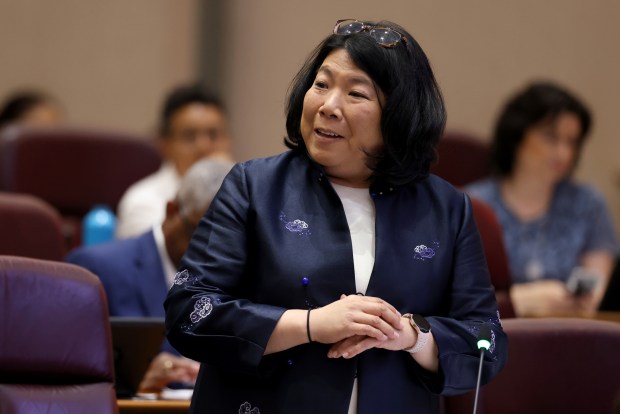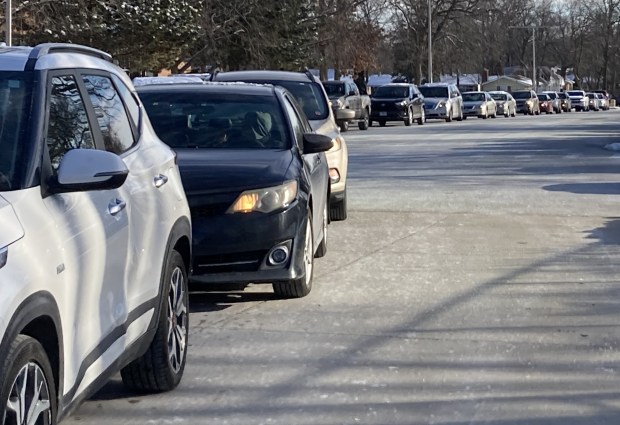The lobby of City Hall was awash in crimson and gold as Mayor Brandon Johnson and a small group of local Asian American politicians convened for a Lunar New Year celebration.
Flanked by a cadre of young, bedazzled Chinese lion dancers, Johnson attempted to honor Ald. Nicole Lee for being the first Asian American to represent Chicago’s 11th Ward. But Lee, also the City Council’s first alderman of Chinese descent, was soon wincing at how he described her Near South Side community — the city’s first Asian-majority ward.
“We’re a city that can elect an Asian American woman to a ward that has been known for its racism,” Johnson declared to the crowd. “But it tells you what’s possible in the city.”
Johnson later told the Tribune he had been nodding to Chicago’s “harsh reality” of deep segregation, and “it’s incumbent upon all of us in this city to address racism that exists around the city.”
He did not elaborate on his reference to the 11th Ward, now home to both Chinatown and Bridgeport. The latter neighborhood played a significant role in the city’s deadly 1919 race riots before becoming a longtime power center for the city’s Irish-controlled Democratic political machine, most notably the home of the Daley family.
That a Chinese American woman now represents the historic ward on the City Council throws into sharp relief the challenges and opportunities facing Asian American elected leaders in the city and region: For generations, racial and ethnic groups have grabbed political power in Chicago, and tried to harness their increasing electoral clout in order to hold onto and expand it. Doing so is by no means assured, however, and the wide diversity of the Asian American experience makes building a successful coalition particularly challenging.
So goes the high wire Lee has walked since being appointed by former Mayor Lori Lightfoot to the City Council in 2022, after a once-a-decade redistricting process afforded Asian residents a precarious 50.1% majority in the new 11th Ward.
Since then, seven other Asian American newcomers to politics have won elected office across Illinois, more than doubling their numbers within two years.
Lee said the recent momentum makes the wide-ranging priorities for Chicago’s Asian community all the more pressing as the budding coalition navigates a renaissance as the city’s fastest-growing racial group, jumping by almost one-third from 2010 to 2020. At the same time, the city’s entrenched racial politics have continued to play out in power struggles between the Black and Latino caucuses, but how the Asian American community fits remains to be seen.
“We absolutely have the opportunity before us to make sure that we don’t backslide, because as it goes in politics, if you’re not at the table, you’re on the menu. We’re at the table now,” Lee said. “Especially now that we’ve got some political power, we don’t want to squander that.”
Two years ago, Lee’s entrance to the City Council catalyzed what many in Chinatown saw as a watershed moment for their community. Now, there are a total of 13 Asian Americans serving in elected office on the city, county and state levels. Following the 2023 citywide election, Chicago now has a record number of two aldermen of Asian descent: Lee and Filipina American Leni Manaa-Hoppenworth, 48th.
Before Lee’s time, Ameya Pawar served as Chicago’s first alderman of Asian descent, representing the North Side 47th Ward from 2011 to 2019.
Illinois’ other Asian American politicians include nine Springfield lawmakers — four hailing from Chicago — with ethnicities from all over the continent. Cook County Commissioner Josina Morita and Lake County Treasurer Holly Kim have held local offices since 2016 and 2018, respectively.
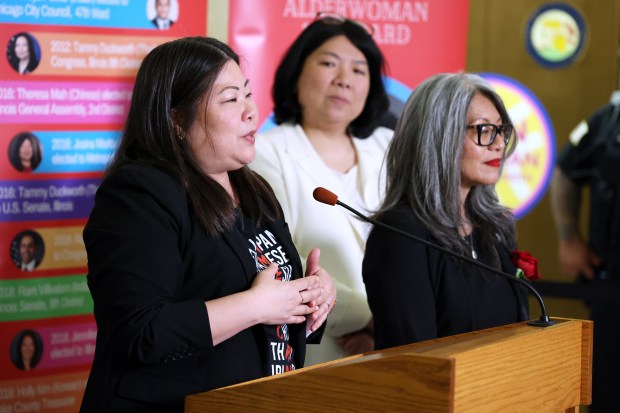
And on the federal level, U.S. Sen. Tammy Duckworth is Thai American, while Schaumburg Rep. Raja Krishnamoorthi is of Indian descent.
Such a big tent was unfathomable to many as recently as eight years ago, when Theresa Mah became the first Asian American ever elected to the Illinois General Assembly, representing Chinatown. Yet, the timing of this political moment has unequivocally lagged behind Chicago’s other communities of color.
“There was this structural exclusion from the political process, right?” Mah said, citing the 1882 Chinese Exclusion Act that banned immigration and citizenship for almost a century. “In cities like Chicago, where a lot of the politics operated along or within this ‘machine politics’ system … because Asian Americans were not allowed to naturalize, and there were very few who could vote, they were overlooked.”
‘Diversity’ without Asians?
As much as Chicago and Illinois have seen an explosion of fresh Asian faces in elected office, some leaders from the community have sounded the alarm over what they see is a regression since Johnson took office in May of last year.
Under Lightfoot, three Asian American women helmed her finance team — CFO Jennie Huang Bennett; Susie Park, budget director; and comptroller Reshma Soni — while Samir Mayekar served as her deputy mayor of economic development. She also appointed Filipino American Chris Brown as her Chicago Public Library commissioner.
Johnson has made zero Asian American appointments to his cabinet and top deputy positions, though he did install Jianan Shi as his Chicago Board of Education president upon taking office. The progressive mayor has touted what he says is “the most diverse administration in the history of Chicago.”
That’s a plaudit Lee challenges.
“How do we define diversity, and where do Asians sit in that equation?” Lee asked. “Describing a group — whatever that group might be — as diverse and not necessarily being inclusive of certain ethnicities, or even age, background, ability, these are all things that I think make up the definition of diversity.”
Manaa-Hoppenworth said she too would like to see more Asian representation in Johnson’s cabinet.
In a phone interview, Johnson’s chief of staff Cristina Pacione-Zayas agreed “there is more work to be done,” but said conversations with Asian American leaders about future appointments are “ongoing.”
“When we’ve used that phrase, ‘diversity,’ it really is to speak to the representation across the city that is reflective of the general population, and that this administration compared to the past two administrations show a significant increase in diversity in particular racial and ethnic categories,” Pacione-Zayas said. “I think what Alderpersons Lee and Manaa-Hoppenworth are speaking to is that there’s more work to be done.”
Johnson’s cabinet is 43% Black, 25% Latino, 30% white and 2% Asian, as the mayor has kept Brown in the CPL post. One vacancy in his leadership team remains — the chief equity officer — and Pacione-Zayas added “there may be future ones.”
There are three Asian Americans leading state agencies, per Gov. J.B. Pritzker’s office: Department of Innovation and Technology Secretary Sanjay Gupta, Department of Public Health Director Sameer Vohra and Environmental Protection Agency Director John Kim.
One of Pritzker’s four deputy governors, Grace Hou with the Health and Human Services division, is the daughter of Taiwanese immigrants. Officewide, the governor’s staffers are 6% Asian American and 42% people of color.
David Wu, executive director of the Pui Tak Center community organization in Chinatown, remembers an era when the thought of the neighborhood amassing political power never crossed other residents’ minds. When he first moved into the ethnic enclave more than 30 years ago, Chinatown was splintered into several different city wards and state districts.
It took a 2011 state law strengthening the rights of racial minority communities to stay intact during redistricting for Chinatown to at last see the Asian Americans in that area grouped into a single district, one that would in five years be won by Mah.
“It was easy just to divide our voice so that we would have less influence,” Wu said. “It’s easy to forget the Asian community. We still don’t yell the loudest. And sometimes it’s easy just to see those success stories without seeing pockets of Asian Americans in Chicago that are really in need.”
Statewide, recent achievements include a 2021 law that made Illinois the first to require public schools teach Asian American history, as well as the Language Equity and Access Act approved by lawmakers last month mandating state agencies provide language access plans and translations in more than a dozen languages.
That issue is one that advocates across the city and state’s Asian diaspora agree is urgent. One of the next goals for them is to strengthen Chicago’s 2015 language access ordinance, along with disaggregating demographic data in order to better understand the wide-ranging need within the community. Pacione-Zayas indicated the Johnson administration is interested in those priorities, too.
Manaa-Hoppenworth, the freshman alderman on the North Side, said she believes her candidacy was overlooked because she didn’t represent the “status quo.”
In last year’s heated 48th Ward race, progressive labor groups such as the Chicago Teachers Union coalesced behind democratic socialist candidate Nick Ward, while outgoing Ald. Harry Osterman endorsed developer Joe Dunne. Dunne lost to Manaa-Hoppenworth in the runoff.
A similar tale unfolded for state Rep. Hoan Huynh, a Vietnamese refugee whose North Side district overlaps with Manaa-Hoppenworth’s ward and who eked out a sleeper victory against a Pritzker-backed candidate in the 2022 Democratic primary.
The two are now the first lawmakers of Asian descent to represent the “Asia on Argyle” cultural district in Uptown.
“A lot of people, in my opinion, they see a woman who’s short,” Manaa-Hoppenworth said. “‘She’s Asian. She’s quiet.’ That is something that people underestimate too often. … Being the underdog is not such a bad thing, actually.”
Unifying the Asian American agenda, from Chinatown to Little India
One May afternoon, Lee and Manaa-Hoppenworth again celebrated their heritage at a luncheon featuring local government employees who identify as Asian. The group of at least 50 milled upstairs in the Cook County building, nibbling on Chinese barbeque and Filipino ube desserts while marveling at how many of them had been in government this whole time.
The next hurdle? How to channel that power.
It’s an age-old question that Black and Latino political coalitions have grappled with over the decades too. But Chicago’s Asian American population of about 190,000, or 7% of the city, is in many ways far less cohesive. The largest communities within that group are those of Chinese descent at 31%, Indian Chicagoans at 23% and Filipino residents at 16%.
But in total more than 30 different Asian ethnic groups have settled in the city, per the 2022 U.S. census. Chinatown alone features dialects from Mandarin to Cantonese to Hokkien to Taishanese.
And the high share of Asian Chicagoans who lack English proficiency — 30% — as well as their far-flung geographic reach have allowed ethnic enclaves to flourish over the decades, but often in silos.
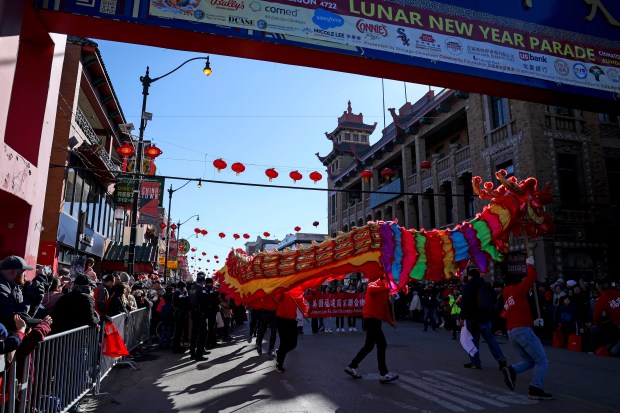
Besides the Chinatown that’s existed on the Near South Side since 1912, after the population was pushed out of its original downtown stronghold, a bustling Vietnamese and Chinese immigrant business corridor has materialized in Uptown since the 1975 fall of Saigon. And on the very northern end of the city, the “Little India” neighborhood along Devon Avenue has attracted a large South Asian population.
“This speaks to the history of even the term ‘Asian American,’” said Grace Pai, executive director of Asian Americans Advancing Justice. “A lot of people who are part of the Asian American community, they identify more with a specific ethnic identity like Korean American, Indian American, Filipino American, and the term ‘Asian American’ came about because people realized we need to come together.”
The concept of a pan-Asian American identity arose after longtime exclusionary immigration laws loosened in 1965, but that nebulous designation has at times come at the cost of erasing the specific needs of low-income and uneducated subgroups. At the same time, the rise of a “model minority” stereotype of the successful, assimilated Asian American percolated in the mainstream.
Asian Americans do have the lowest poverty rate nationwide after white people, at 1 in 10, and are the most likely to be college-educated. But about 18.2% of Chicagoans of Asian descent live below the poverty line, the second-highest rate after the Black population at 28.7%, according to the U.S. Census Bureau.
Shobhana Verma, executive director of the South Asian American Policy and Research Institute based on the North Side, noted that even within the South Asian population, there is “polarization” that risks distracting from common causes.
“We are working with a community that does not necessarily have a history, first of all, of being so large or being so engaged,” Verma said. “Our identities are very heterogeneous, embracing multiple religions, different beliefs and values and languages, sexual orientations and a diversity of ethnicities. How can we all think and vote or experience the same things?”
Politically, Asian voters in Chicago and the U.S. remain overwhelmingly Democratic, but that too is a wide umbrella. In the 2023 mayoral runoff, Lee’s Chinatown precincts were some of the most-solid strongholds for Paul Vallas, Johnson’s more conservative challenger, while Manaa-Hoppenworth’s ward went for Johnson, including around Uptown’s Asian enclave.
Even when Lee ran to retain her seat, she faced an internal challenge from the Chinese community in Chicago firefighter Don Don, who came in third with about 20% of the vote.
Anita Lau, co-chair of the Chinatown Special Events organization and a Chinatown resident since 1963, said she wants the community to be more intentional about unifying behind a candidate in the future.
“My suggestion will be just one Asian to be a candidate, not about two or three Asian in the same position because they will separate the voters,” Lau said. “To me, they should be work together instead of separate the voters because sometime when you separate the voters, that will only benefit the other people.”
But other Asian community leaders said the surge in participation is a good thing because it dispels the notion that their communities are uninterested in politics.
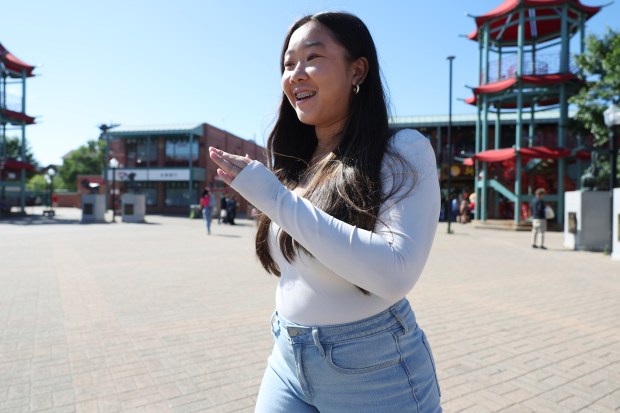
Keeley Chiu, a junior at Jones College Preparatory, said she remembers her first political awakening took place when she accompanied her father to the polls around the age of 10, proudly slapping his “I Voted” sticker on her own shirt.
Now 17 years old, the Chinatown resident said she persuaded him to help her to knock on doors for Lee’s aldermanic campaign after school and on weekends. Through the biting winter, the pair zigzagged through senior building complexes, her father taking over for the Cantonese-speaking elders while she conversed in English.
Keeley said that she is not alone among Gen Z Asian Americans in getting involved with politics.
“A lot of the time Asians are forgotten as a minority,” Keeley said. “Our Asian community, I think, definitely needs to be more recognized.”


